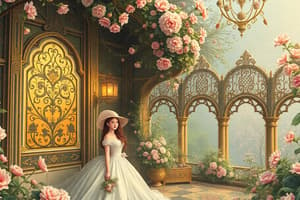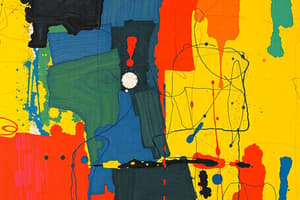Podcast
Questions and Answers
What plays a crucial role in producing quality artwork across various art forms?
What plays a crucial role in producing quality artwork across various art forms?
- A deep understanding of art history
- Experimentation with different materials
- Mastery of specific skills and techniques (correct)
- Collaboration with other artists
Which source of inspiration is often associated with artistic creativity?
Which source of inspiration is often associated with artistic creativity?
- Formal art education
- Public criticism
- Emotional states (correct)
- Financial incentives
How are artworks commonly interpreted?
How are artworks commonly interpreted?
- Using standardized criteria for evaluation
- In a universal manner across cultures
- Based solely on technical skill
- Through personal and cultural context (correct)
What aspect of society does art influence significantly?
What aspect of society does art influence significantly?
What benefit does art provide on a personal level?
What benefit does art provide on a personal level?
Which of the following best describes visual arts?
Which of the following best describes visual arts?
What function of arts involves providing a critique of societal norms?
What function of arts involves providing a critique of societal norms?
Which category of arts primarily focuses on written language and storytelling?
Which category of arts primarily focuses on written language and storytelling?
Which of the following functions of arts is related to evoking emotional responses?
Which of the following functions of arts is related to evoking emotional responses?
How do arts contribute to economic value?
How do arts contribute to economic value?
Which aspect of artistic creation is essential for innovative thinking?
Which aspect of artistic creation is essential for innovative thinking?
Which aspect of arts helps in passing down traditions through generations?
Which aspect of arts helps in passing down traditions through generations?
Which type of arts includes live performances and audience interaction?
Which type of arts includes live performances and audience interaction?
Flashcards
Artistic Medium and Materials
Artistic Medium and Materials
The materials and methods used to create art, affecting its visual and technical aspects.
Artistic Inspiration
Artistic Inspiration
Ideas and feelings that spark an artistic creation, often coming from personal experiences, observations, culture, or emotions.
Context and Interpretation in Art
Context and Interpretation in Art
Understanding how art relates to its time and place, considering its historical, cultural, and social context. Different people can interpret art in unique ways.
Art's Influence on Society
Art's Influence on Society
Signup and view all the flashcards
Art's Impact on Individuals
Art's Impact on Individuals
Signup and view all the flashcards
What are the arts?
What are the arts?
Signup and view all the flashcards
What are the visual arts?
What are the visual arts?
Signup and view all the flashcards
What are the performing arts?
What are the performing arts?
Signup and view all the flashcards
What are literary arts?
What are literary arts?
Signup and view all the flashcards
What is aesthetic appreciation in arts?
What is aesthetic appreciation in arts?
Signup and view all the flashcards
What is the role of arts in social commentary?
What is the role of arts in social commentary?
Signup and view all the flashcards
How do arts preserve culture?
How do arts preserve culture?
Signup and view all the flashcards
What is the economic value of arts?
What is the economic value of arts?
Signup and view all the flashcards
Study Notes
Defining Arts
- Arts encompass a diverse range of human activities and expressions, including visual arts, performing arts, and literary arts.
- These activities often involve imaginative creation and aesthetic qualities, aiming to communicate ideas, emotions, or experiences.
- Arts can be understood as a form of cultural expression reflecting social values, beliefs, and historical contexts.
Types of Arts
- Visual Arts: This category includes painting, sculpture, drawing, printmaking, photography, and graphic design.
- Visual arts often use elements like color, line, form, and texture to create a visual effect.
- They can range from highly realistic depictions to abstract and non-representational styles.
- Performing Arts: This category includes music (instrumental and vocal), drama (theater), dance, and opera.
- Performing arts typically involve live performances and interactions with an audience.
- The elements of performance may include music, choreography, costumes, set design, and acting.
- Literary Arts: This category includes novels, poems, short stories, plays, and essays.
- Literary arts utilize language and storytelling to create narratives, evoke emotions, explore ideas, and offer insights into human experience.
- Literary works can vary widely in style, form, and thematic content.
Functions of Arts
- Aesthetic Appreciation: Arts can evoke strong emotional responses and offer visual and auditory pleasure through their aesthetic qualities.
- Social Commentary: Arts can offer critiques of society, challenge prevailing norms, and raise awareness about social issues.
- Cultural Preservation: Arts play a significant role in transmitting cultural heritage, traditions, and beliefs from generation to generation.
- Historical Documentation: Artworks often serve as historical records, offering insights into past societies, their values, and their daily lives.
- Emotional Expression: Arts provide a powerful outlet for expressing a wide range of emotions, conveying experiences, and facilitating self-discovery.
- Cognitive Stimulation: Engaging with arts can stimulate creativity, imagination, and critical thinking.
- Economic Value: Arts can contribute significantly to the economy through tourism, employment, and cultural industries.
Key Aspects of Artistic Creation
- Creativity: Artistic creation often involves innovative thinking, imagination, and the ability to develop original ideas and expressions.
- Skill and Technique: Mastery of specific skills and techniques is often crucial to producing quality artwork in various art forms.
- Inspiration and Motivation: Artistic inspiration can stem from various sources, including personal experiences, observations of the world, cultural influences, and emotional states.
- Medium and Materials: The materials and techniques used in artistic creations are integral to the artwork's aesthetic and technical aspects.
- Context and Interpretation: Art is often understood and appreciated in its historical, cultural, and social context. Interpretations of artworks can vary considerably, reflecting diverse perspectives and individual experiences.
Art and Society
- Arts and culture are deeply intertwined with society, influencing and being influenced by social values, political movements, and economic conditions.
- Art can reflect, challenge, and shape societal beliefs, values, and behaviors.
- Artistic movements often arise in response to specific historical and social contexts.
- The appreciation and consumption of art are shaped by societal attitudes, cultural norms, and economic factors.
Impact of Arts on Individuals
- Art can contribute to personal growth and development by fostering creativity, emotional intelligence, and self-expression.
Conclusion
- Arts are a multifaceted and essential aspect of human experience.
- They provide avenues for creativity, expression, understanding, and connection across cultures and generations.
Studying That Suits You
Use AI to generate personalized quizzes and flashcards to suit your learning preferences.




